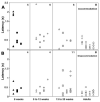Human infants' accommodation responses to dynamic stimuli
- PMID: 17251499
- PMCID: PMC2755532
- DOI: 10.1167/iovs.06-0734
Human infants' accommodation responses to dynamic stimuli
Abstract
Purpose: A young infant's environment routinely consists of moving objects. The dynamics of the infant accommodative system are almost unknown and yet have a large impact on habitual retinal image quality and visual experience. The goal of this study was to record infants' dynamic accommodative responses to stimuli moving at a range of velocities.
Methods: Binocular accommodative responses were recorded at 25 Hz. Data from infants 8 to 20 weeks of age and pre-presbyopic adults were analyzed. A high-contrast image of a clown was moved between 20- and 50-cm viewing distances at four velocities (a step, 50 cm/s, 20 cm/s, and 5 cm/s).
Results: Most infants who had clear responses were able to initiate their response within a second of stimulus onset. The infants were able to discriminate the different stimulus velocities and to adjust their response velocities and durations in an appropriate fashion.
Conclusions: The data indicate that by the third postnatal month infants are able to respond with latencies within a factor of two of adults' and that there is little immaturity in the motor capabilities of the accommodative system compared with the sensory visual system at the same age.
Figures








References
-
- Sur M, Leamey CA. Development and plasticity of cortical areas and networks. Nat Rev Neurosci. 2001;2:251–262. - PubMed
-
- Troilo D. Neonatal eye growth and emmetropization—a literature review. Eye. 1992;6:154–160. - PubMed
-
- Saunders KJ, Woodhouse JM, Westall CA. Emmetropisation in human infancy: rate of change is related to initial refractive error. Vision Res. 1995;35:1325–1328. - PubMed
-
- Smith EL, 3rd, Hung LF. The role of optical defocus in regulating refractive development in infant monkeys. Vision Res. 1999;39:1415–1435. - PubMed
-
- Cook RC, Glasscock RE. Refractive and ocular findings in the newborn. Am J Ophthalmol. 1951;34:1407–1413. - PubMed
Publication types
MeSH terms
Grants and funding
LinkOut - more resources
Full Text Sources

